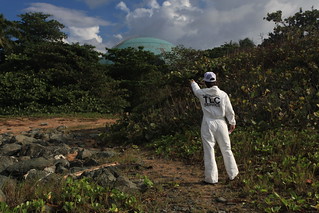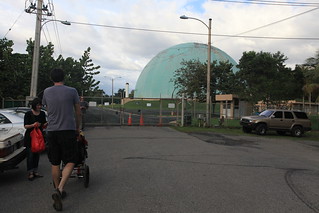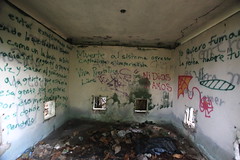On Saturday, November 17, National TLC Service personnel conducted a site visit to the shuttered BONUS (Boiling Nuclear Superheater) reactor, located directly adjacent to a legendary surfing beach near Rincón, Puerto Rico. While current and former military installations dot US territory – and encompass much of the commonwealth’s smaller land mass, Vieques, the BONUS reactor is the only site in Puerto Rico supervised by the Department of Energy’s Office of Legacy Management. The National TLC Service made the two-hour drive from San Juan to learn more about it.
Built by General Electric, the US Atomic Energy Commission, and the Puerto Rico Water Resources Authority, 18-MW BONUS reactor on the northwest coast of Puerto Rico was constructed from 1960-1963 and went critical in 1964. The construction of the prototype plant, designed to establish the feasibility of the integral boiling-superheating concept, must be understood in light of three mid-twentieth century development programs pursued by the US government as civil society extensions of the Cold War. Most directly, the reactor was an extension of the Atoms for Peace program established in 1953 to develop civilian applications of nuclear fission in order to build public, especially international, support by taking the image of nuclear technology. But it was also constructed in the context of Operation Bootstrap, a program begun in 1948 to transform Puerto Rico from a rural, agrarian society into an industrially-oriented economy that functioned as a quasi-offshore entity for US corporations (with lower labor costs, duty-free imports, and tax-protected profits). Finally, the reactor was constructed during some of the tensest years of the Cold War, as the United States reacted to the Cuban Revolution with great anxiety, military escalation, and diplomatic activity, eventually establishing the Alliance for Progress (1961) to foster economic development throughout Latin America in keeping with a pro-US, free-market model. The position of the reactor on the island—looking back to the mainland United States over Haiti, the Dominican Republic, and Cuba—is if not strategic than certainly symbolic within the geopolitical situation at that time.
Regardless of various reasons for its construction, the BONUS reactor’s operational life was very short. Running at full power only from 1965-1968, its operation was terminated due to technical difficulties. Following the removal of spent fuel and special nuclear materials back to the continental US and the entombing of the reactor vessel and internal components in concrete and grout, BONUS achieved listing on the National Park Service’s National Register of Historic Places in 2008, and a museum of atomic science was established on the site. By the time of our visit, however, there was no evidence of the museum, and reactor campus was enclosed by a locked chain-link fence, rusty from the salt air. A single car—probably a security guard’s—was parked inside the fence, but we saw no evidence of its owner. The most visible protection was provided by stray dogs who had taken up residence inside the fence and barked almost continually at the beach traffic parking just outside the gate. The reactor’s striking architecture has, in fact, lent its name to this surfing hot spot: the beach is known as “Domes.”
We scampered down a muddy hill to the beach, then rounded a rocky point to glimpse the reactor from the ocean. The green dome rose over the tropical canopy, a rusting monument to a century that dawned in Puerto Rico under U.S. military rule after centuries of Spanish control. Comparisons between BONUS and the fortification around San Juan were perhaps inevitable. On one side of the island, Spanish castles projected hard power from limestone walls. On the other side of the island, the reactor projected an apparently softer power, the promise of technology and modernization, backed with the unfathomably harder power of nuclear weapons. This sleeker, more modern form of colonialism is still hard to recognize, while the other far easier to romanticize. These two nationally-recognized ‘historic places’ attract far different numbers and kinds of visitors each year as a result.
Crossing the beach, we found a very muddy trail running alongside the reactor’s perimeter fence. Following it, we came upon a ruined outbuilding—perhaps part of the plant’s water cooling intake—repurposed for various recreational activities and bedecked with anti-imperialist, anti-police, pro-drug sentiments. An adjacent structure had collapsed to the forest floor. The vines reclaiming it offered shelter to a diversity of iguanas, hermit crabs, frogs, and insects. In this tropical ecosystem, the very existence of the trail was evidence of its maintenance, and as we continued we found more signs pointing to the dance between adventure-seekers and boundary-enforcers: patched fence, cleared brush, piled trash. If efforts to transform BONUS into a legitimate tourist destination through the museum failed, energy is clearly being expended to prevent its becoming an unofficial attraction.
In the absence of an institutional presence on site, inquiries about the reactor’s history and any remaining contamination are met with either bureaucracy or local lore. The Department Of Energy’s Office of Legacy Management—the long-term steward of post-Cold War domestic legacies (i.e., hazards)— holds jurisdiction over the BONUS site and posts information about the closure and cleanup and annual monitoring reports online, but these contain little evidence of public outreach or involvement, aside from references to the museum. Several Puerto Ricans we asked about the reactor were unsure if it had ever been operational but were quite concerned about seismic activity in the area: the Puerto Rico Trench is about 100 kilometers north of the island, and various large and small fault lines are associated with it. Unless this seismic threat is realized, the site is likely to be more forgotten than commemorated: a once-upon-a-time experimental nuclear zone overlaid on a tropical surfing “hot spot.”





